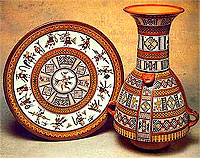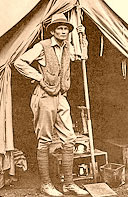|
Inca pottery art was heavily
influenced by geometry, and many of
the designs and patterns used in
Inca pottery were based on geometric
shapes and patterns.
One of the
most common geometric motifs found
in Inca pottery is the step pattern,
which is made up of a series of
triangular steps or terraces. This
pattern was used to create a sense
of depth and dimensionality in the
design, as well as to create a sense
of movement and rhythm.
Another
common geometric motif found in Inca
pottery is the spiral, which was
used to represent the cyclical
nature of life and the cosmos.
Spirals were often used in
conjunction with other geometric
patterns, such as the step pattern,
to create more complex and intricate
designs.
Inca potters also used
mathematical principles to create
symmetrical and balanced
compositions. For example, they
would use the principle of
reflection to create mirror-image
designs, and they would use grids
and other mathematical tools to
create designs with precise
proportions and symmetry.
Overall, Inca pottery art
demonstrates a deep appreciation for
the principles of geometry and
mathematics, and the intricate
designs and patterns they created
continue to inspire and fascinate
people today.
Hiram Bingham, the American explorer who found the
ruins of Machu Picchu in 1911, wrote:
In addition to agriculture and the breeding
of useful plants and animals, the Incas carried to a remarkable extreme
the manufacture of graceful, symmetrical pottery. They learned to
recognize different kinds and qualities of potter's clay. They selected
localities marked by the finest type of clay for the worship of
favorable divinities and the manufacture of the most delicate dishes. It
seems likely that a form of potter's wheel must have been used in the
manufacture of their jars.
There was nothing crude or uncouth about
their pottery. Most of it was made with the utmost skill, hard finished
with polished and painted surface from which every trace of the process
of manufacture had been removed. Unlike the primitive pottery of the
Indian tribes in the Amazonian Basin, and in many parts of America, Inca
pottery gives abundant evidence, in its symmetry and fine proportions,
as well as in its finish, that the makers were the inheritors of a
thousand years of culture and love of beauty. Their pieces were
admirably designed for the uses to which they were put and just enough
decoration to please and satisfy the most fastidious owner.
On the Peruvian coast, the ancient peoples
who were conquered by the Incas carried their pottery making to a much
more elaborate degree than did the Incas. Inca designs were nearly
always geometrical and conventional. They included squares repeated one
within the other, cross-hatching, rows of triangles, parallel lines,
rows of lozenges, elaborate scrolls, a conventionalized necklace design
consisting of a large number of disks each suspended by separate strings
from the principal cord. This necklace design may possibly have been a
representation of the royal fringe of sovereignty, the crown of the
Incas.
The bar and double-cross pattern which
occurs frequently on the handles of Inca pottery is clearly imitative of
ancient basketry and derives from the easiest from of making handles.
The pattern took the fancies of the ancient potters and consequently
reappears in various panels and frequently constitutes the central
portion of a geometrical design.
The most striking Peruvian pottery exhibited
in collections comes from the sea-coast of northern Peru, where, before
the days of the Inca Empire, native potters excelled in producing
realistic human groups and even vivid portraits. Some of the Peruvian
coastal pottery still stands unequaled in the life-like portrayal of
human action and emotion. One finds the naked body depicted in many
attitudes, some of them so degenerate as to be excluded from public
exhibits. Mannequins in every conceivable posture, tragic groups
representing human sacrifices, humorous caricatures of intoxication,
persons afflicted with terrible diseases, comedy and tragedy, all are
found represented in coastal ceramic art. The striking lack of any such
tendencies in the pottery of the Incas leads to the conclusion that they
must have had a strong prejudice against the use of the human form in
decoration. The growth of such strict ideas of decency would naturally
promote a sense of shame which would lead to the practice of using
geometric patterns or conventionalized birds and animals rather than the
human form. Consequently it is not surprising that Inca pottery does not
represent the human form even though their highly developed sense of the
beautiful induced them to make jars and dishes as graceful as those of
ancient Greece. Practically all the pottery found in our excavations
at Machu Picchu was pure Inca.
|

Inca effigy jar from Machu Picchu
(Photo: Yale Peabody Museum) |
The most characteristic Inca pattern and the
most common of the vessels intended for holding liquids was a
bottle-shaped vase with a pointed bottom, frequently two and
two-and-a-half feet in height and capable of holding six or seven
gallons of chicha (corn beer) with two band-shaped handles
attached vertically to the lower body, and a strikingly long neck. Each
jar as a rule has two pierced, ear-like nubbins attached to its rim. The
front of each bottle-shaped vase has on its shoulder a stout nubbin
decorated to represent the conventionalized head of a fierce sometimes
ears, lips, teeth and even nostrils. It has been suggested that the
makers believed that the ill-natured demon who caused good chicha
to be spilt might be frightened away by this uncouth animal. These
nubbins could have been used to tie on a cover to keep the precious
chicha from spilling, or for decorative tassels which would indicate
the quality of the maker of the beverage. Since these jars were intended
to be carried on the back and shoulders by means of a rope passed
through the handles and around the big nubbin, they were nearly always
decorated on only one side, and the side which rubbed against the back
of the carrier was left undecorated. Although not at all like a Greek
aryballus, that name has been applied to it by Peruvian writers for many
years. So far as I know it is not found in any part of the world except
where Inca civilization prevailed. Many examples of it were found at
Machu Picchu.
A shallow dish or saucer used for drinking
has a handle on one side, sometimes a broad loop but more often the
conventionalized head of a friendly bird or animal, which sets
comfortably under the thumb, and a small raised decoration on the
opposite rim. These dishes are always carefully made, attractively
painted only on the inside with elaborate geometric patterns.
In a mountain region where is little fuel
for open fires and where the drinking of cold water frequently brings on
mountain sickness which is often disastrous, it is natural that the
craving of the body for additional heat and liquid should be gratified
by soup and beer. The utensils used for chicha are carefully
painted and polished. In this they differed markedly from the
fire-blackened cooking pots, or ollas, in a which the Incas made
their soups and stews.
|

Inca Pottery |
A common form of olla has a handle on
one side and a single foot or base. The side opposite the loop handle is
usually decorated in low relief, possibly the echo of the base of a
second handle. These beaker-shaped ollas were usually nine or ten
inches high. The form undoubtedly was the introduction into the fire of
a simple two handled pot. Then somebody discovered that by adding a base
or a foot to it the pot could stand better in the embers of a small
fire. Later the discovery was made that only the handle nearest the cook
was really necessary since the other handle got too hot to be of much
use and it was finally abandoned, its place being taken by a little
ornament in low relief that was attached to the pot just before it was
baked.
Another common design was a two-handled food
dish with band-shaped handles ordinarily attached horizontally below the
rim, wider than it is high and broad enough so that the hands of the
diners might readily extract the delicacies therein, undoubtedly stews,
which were not used in the fire, but were of fine clay, carefully
polished and soberly decorated on both sides with conventional geometric
patterns.
Loving cups and dishes connected with
drinking chicha were frequently amusingly decorated with fierce
looking jaguars or pumas glaring at each other with open mouths and
bared teeth. Or the handle might consist of the head of a laughing fox
or coyote, exquisitely modeled. The spirit in which the modeling of
these Inca dishes was worked out shows great artistic ability and
frequently a nice sense of humor. Sometimes a drinking jug would be made
in the form of a fat man with his hands comfortably supporting his
stomach.
Perhaps one of the most interesting and
rarest forms of Inca pottery was a three-legged brazier with a
band-shaped handle attached to its top, its mouth irregular in form,
placed on one side. In the top are three openings or vent holes, the
legs are solid and cylindrical and long enough to permit of a small
fire-blackened within and without. The Incas metallurgists gave them
such hard usage that the frail little braziers did not last long and no
perfect specimens have been found.
The usual size of the three-legged brazier
was about seven inches high, six inches wide and seven inches long. They
appear to have intended for a charcoal fire in which metal could be kept
hot while being worked. The vent holes on top would have admitted the
insertion of blow pipes, a practice referred to in several of the early
Spanish chronicles, and they were made thin enough to enable them to be
rapidly heated. They were undoubtedly used in the manufacture of bronze
knives, axes, chisels, and shawl-pins in which repeated heating and
annealing were necessary.
Source:
‘Lost City of the Incas, The Story of Machu
Picchu and its Builders’ by Hiram Bingham
The American explorer who found the ruins of Machu Picchu in 1911.

Hiram Bingham at Machu Picchu
The inspiration for Indiana Jones?
|